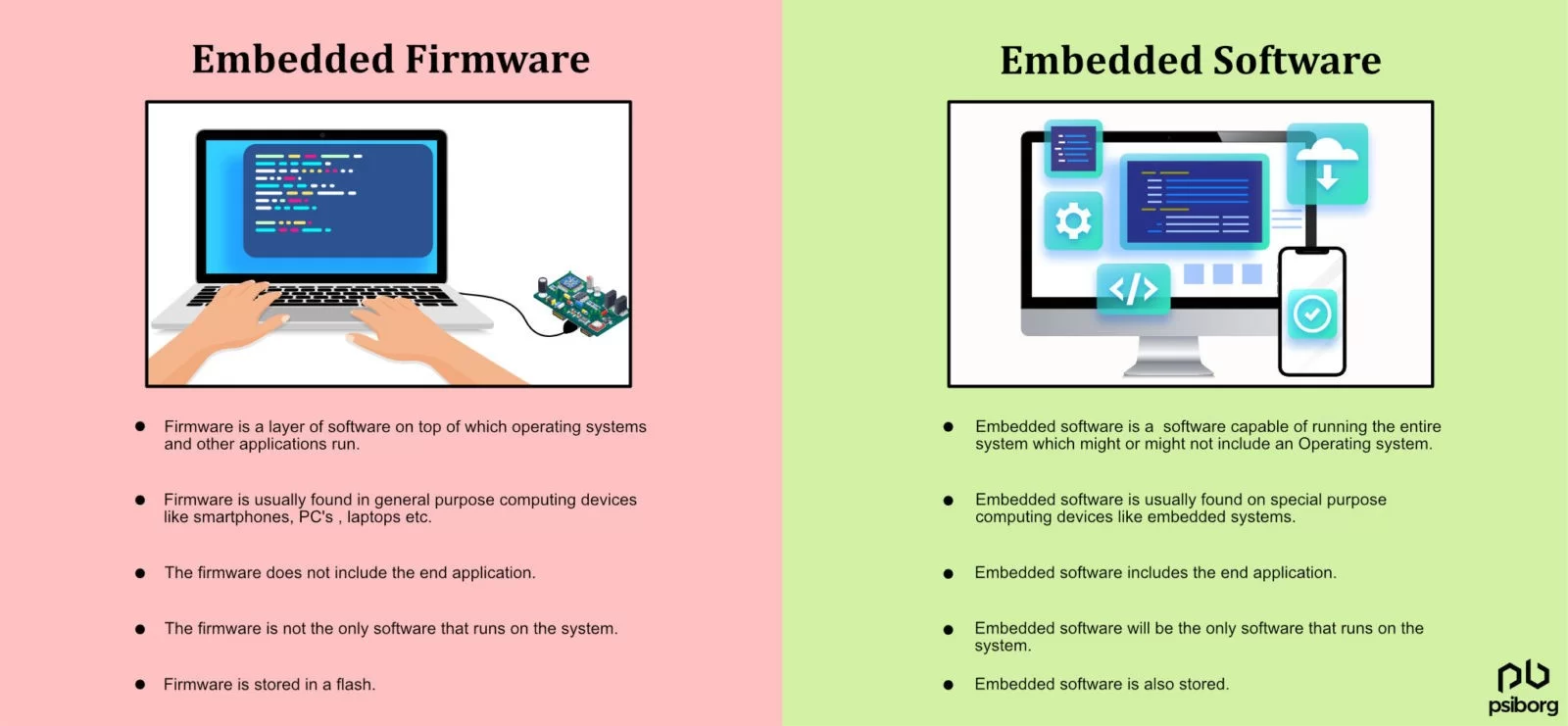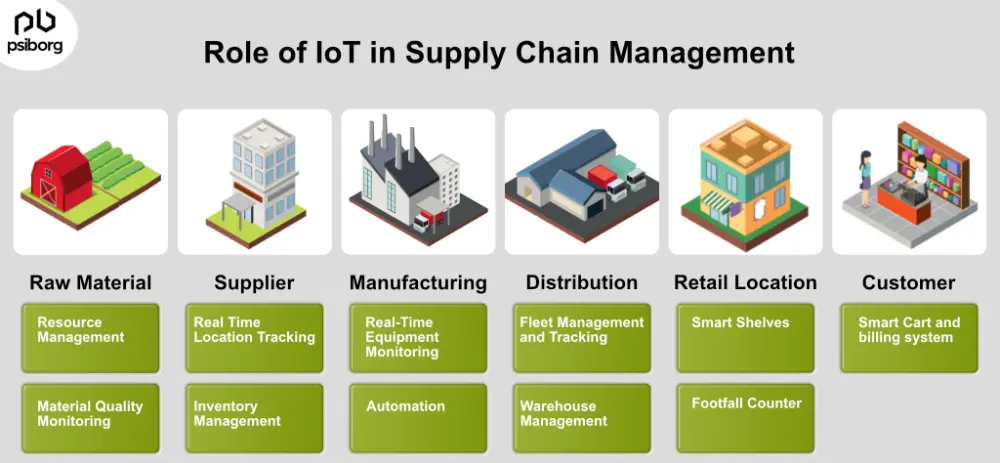With the gradual and powerful development of IoT products for distinct applications, more and more software developers are inclining toward embedded software development. In fact, it is the need of the hour as hardware and software both need a compact approach. Software development in an embedded system is highly complex. Let’s have a look at how the embedded firmware development process works.
Firmware developers require to obtain a definite understanding of the internal workings of the embedded processor and microcontrollers. They also require thorough experience with embedded hardware. While the difference between hardware and software is clear to many, firmware is a blurry concept to most. How is it different from software? There are many questions and doubts related to it.
Reading this will certainly clear up most of those questions that come to your mind. Give a quick read and get a better idea of the overall process.
WHAT ARE EMBEDDED FIRMWARE AND EMBEDDED SOFTWARE?
- Embedded software: The simplest answer to define what embedded software is, would be the software essential for carrying out operations for any embedded system which might or might not include an OS. It gets installed on the embedded system and works as fuel to run it through an end application. Embedded software is specific for a device and incompatible with a different device, unlike other application software.
- Embedded Firmware: Firmware is a set of instructions programmed or a software program on a hardware device. It supplies the essential instructions for the device to communicate with other hardware parts. It is a specific type of software providing low-level control for a particular hardware part. To put it in simple words, it is software programmed on a hardware device that operates like basic input/output to perform specific hardware functions.

INTRODUCTION TO EMBEDDED FIRMWARE DEVELOPMENT
The firmware is a flash memory chip storing specialized software functioning in an embedded device for controlling its functions.
Embedded Firmware Development is nothing but writing codes on hardware that can run on embedded hardware. Developers who perform this have a profound understanding of embedded processors and work closely with engineers who specialize in embedded hardware. They input the codes on the embedded designs. Firmware codes can control distinct functions of varied hardware devices.
The hardware code can be updated wirelessly, which is known as FOTA (Firmware Over the Air)
DIFFERENT SKILLS REQUIRED FOR EMBEDDED DEVELOPMENT
For any developer to become an expert in Embedded Firmware Development, they need a complete theoretical and practical idea about both the software and hardware components. The chances of writing a well-functioning code are less if he/she lacks knowledge of one or the other.
To give you an overall idea, the developer needs to have these three basic ideas other than technical skills –
- Have a clear understanding of the entire embedded system.
- A compact knowledge of hardware and software.
- Understand the limitations of the system’s structures.
Coming to technical skills, involves a combination of three things – Embedded programming languages, real-time operating systems, and device drivers. To mention a few of the prime criteria:
- C and C++ programming, MCUs, microprocessors.
- Linux OS, Real-time-OS, and Software optimization skills at the System on a Chip (SoC) level.
- Debugging skills, updating skills for already existing codes.
- Understanding of data structure, Python programming language, ability to understand schematic and datasheet.
- RISC-V instruction set architecture, understanding of communicating protocols.
- A clear understanding of the Internet of Things (IoT) and internet-based technologies.
5 KEY STEPS TO EMBEDDED FIRMWARE DEVELOPMENT LIFE CYCLE

For those who do not have a clear idea of the overall functioning of Embedded Firmware Development, it is better to go step-wise. This way, you get a segmented approach and divide the complex functioning. There are five broad steps that cover the complete development process of an IoT product. A quick read will clear all the doubts.
STEP-1: IDENTIFY THE REQUIREMENTS FIRST
Identifying the requirements related to the process is always the key step. Before beginning with the architecture side of it, the developer needs to jot down the associated components required. The method of identification also links the utility aspect. You have to recognize what you need and, most importantly, why you need it.
Unambiguous and testable are the two features associated with every requirement statement. The statement needs to be precise, clear, and concise. Testing is a crucial part as, without it, you cannot verify the usability. This step may seem like a general one, but it is the foundation step of any Embedded Firmware Development process.
STEP-2: DIFFERENTIATE THE ARCHITECTURE FROM THE DESIGN
This step is to bring better clarity. You have understood till now that this is a combined process of software and hardware. But there is always a separating factor between the two. If a developer gets confused between the varied layers of firmware engineering, the job gets tough!
The architecture explains the persistent features. As it is hard to change or update, the developer has to understand it first and make changes in the code to make it apt. Architecture never includes variables or functions; it is more of a scale model. In contrast, the firmware design document provides fine details, including the responsibilities of the tasks within device drivers. It also gives away information about interfaces between the subsystems.
STEP-3: MANAGING THE TIME
The timeliness requirement falls under this step. Most of the products have a mix of hard, soft, and non-real-time requirements. The soft real-time ones are highly challenging to define, and the easiest way to manage them is by treating them as hard-real-time requirements.
It is essential to keep the real-time functionalities distinct from the bulk of software for two prime reasons-
- Simplifying the design and operation of non-real-time software as it reduces the safety worries even while using the codes of novice coders.
- By segregating ISRs and high-priority tasks, the effort required to perform RMA or rate monotonic analysis gets reduced.
Suggested Reading: THINGS EVERYONE SHOULD KNOW ABOUT EMBEDDED SOFTWARE DEVELOPMENT.
STEP-4: DESIGN FOR TESTING
The next step is very significant. It involves multiple evaluation steps to determine if the whole system works. The following are three of the most commonly implemented testing processes-
- System test: It verifies whether the whole product meets the requirements. Generally, this testing does not fall under the department of engineers but fits into the test harness created by them.
- Integration test: This test verifies that the subset of the associated subsystems in the architecture is interacting as it should. It checks if the output is right. Generally, this testing is best developed by a testing group or any software engineer,
- Unit test: In this testing step, it involves individual software components to understand if they are working fine at the intermediate design level. Those who write code under the test are the best ones to develop this testing.
STEP 5: CUSTOMIZING PLANS
This step includes the management of the customizing abilities. For implementing or making any changes, this step is vital. With a well-designed architecture, diversity is easy to manage. It aims to make the new customizations work without disrupting the original functionalities.
Suggested Readings: AUTOMOTIVE EMBEDDED DEVICES
TIPS TO ACCELERATE EMBEDDED FIRMWARE DEVELOPMENT PROCESS
- Looking for ways to innovate and update. Improvement is always the key factor.
- Creating a skill improvement plan by learning the new techniques for Embedded Firmware Development.
- Start using a platform and balance the workload by segmenting wisely.
- Develop codes that can get used again to manage the time. It helps in getting better ROI.
BEST EMBEDDED SOFTWARE DEVELOPMENT TOOLS LIST 2021
There are many to name, but some of the most popular ones are:
- PyCharm
- WebStorm
- Qt Creator
- MPLAB X
- Visual Studio
- Eclipse
- NetBeans
- MATLAB
- Arduino
- ARM Keil
Also Read: IOT HARDWARE DESIGN AND DEVELOPMENT SERVICES and TIPS AND TOOLS FOR EMBEDDED FIRMWARE DEVELOPMENT
So, this is the answer to most of your doubts related to Embedded Firmware Development. By reading this, you get an overall idea about what it is, how it works, and other aspects related to it.
PsiBorg provides Full-stack IoT development and specializes in Rapid IoT prototyping because of our IoT journey for several years.
Looking to develop an IoT product? Reach out to us.






